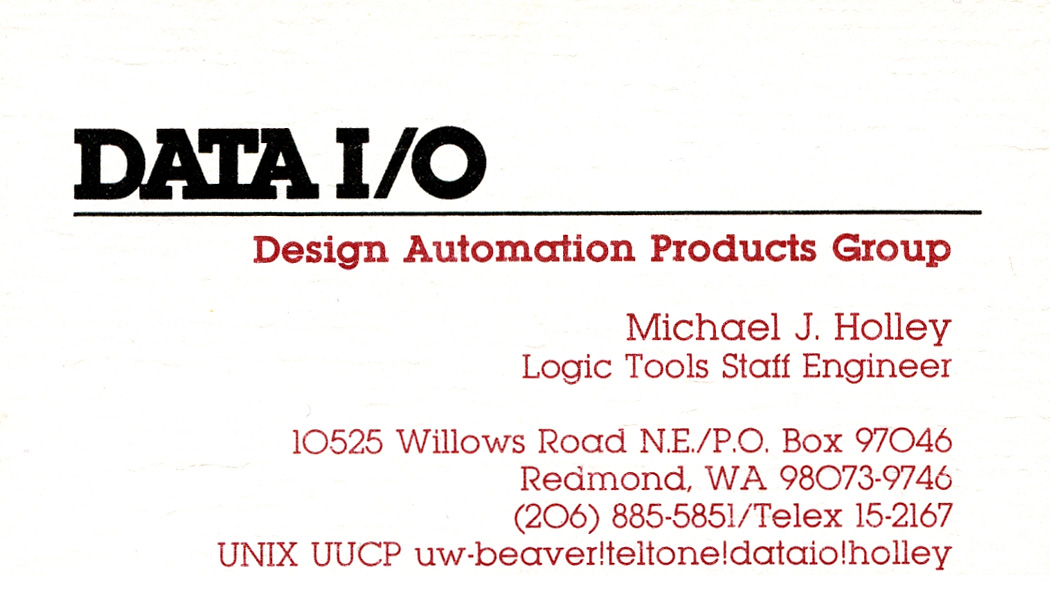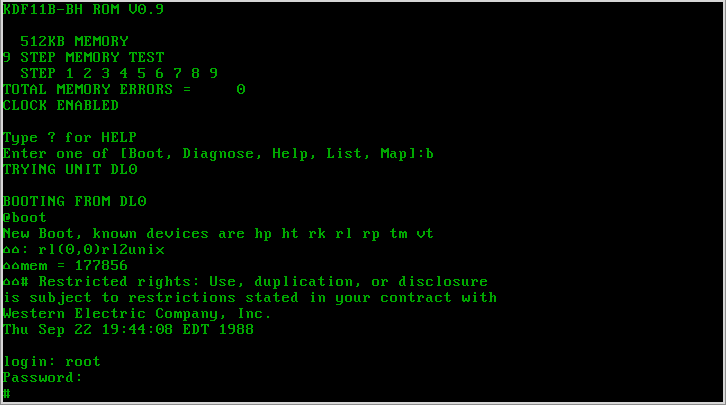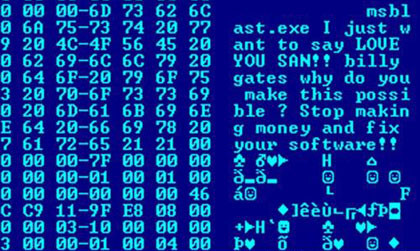|
Bang Path
UUCP (Unix-to-Unix Copy) is a suite of computer programs and protocols allowing remote execution of commands and transfer of files, email and netnews between computers. A command named is one of the programs in the suite; it provides a user interface for requesting file copy operations. The UUCP suite also includes (user interface for remote command execution), (the communication program that performs the file transfers), (reports statistics on recent activity), (execute commands sent from remote machines), and (reports the UUCP name of the local system). Some versions of the suite include / (convert 8-bit binary files to 7-bit text format and vice versa). Although UUCP was originally developed on Unix in the 1970s and 1980s, and is most closely associated with Unix-like systems, UUCP implementations exist for several non-Unix-like operating systems, including DOS, OS/2, OpenVMS (for VAX hardware only), AmigaOS, classic Mac OS, and even CP/M. History UUCP was original ... [...More Info...] [...Related Items...] OR: [Wikipedia] [Google] [Baidu] |
Mike Lesk
Michael E. Lesk (born 1945) is an American computer scientist. Biography In the 1960s, Michael Lesk worked for the SMART Information Retrieval System project, wrote much of its retrieval code and did many of the retrieval experiments, as well as obtaining a BA degree in Physics and Chemistry from Harvard College in 1964 and a PhD from Harvard University in Chemical Physics in 1969. From 1970 to 1984, Lesk worked at Bell Labs in the group that built Unix. Lesk wrote Unix tools for word processing ('' tbl'', '' refer'', and the standard ''ms'' macro package, all for ''troff''), for compiling ('' Lex''), and for networking (''uucp''). He also wrote the Portable I/O Library (the predecessor to stdio.h in C) and contributed significantly to the development of the C language preprocessor. In 1984, he left to work for Bellcore, where he managed the computer science research group. There, Lesk worked on specific information systems applications, mostly with geography (a system for dr ... [...More Info...] [...Related Items...] OR: [Wikipedia] [Google] [Baidu] |
Version 7 Unix
Version 7 Unix, also called Seventh Edition Unix, Version 7 or just V7, was an important early release of the Unix operating system. V7, released in 1979, was the last Bell Laboratories release to see widespread distribution before the commercialization of Unix by AT&T Corporation in the early 1980s. V7 was originally developed for Digital Equipment Corporation's PDP-11 minicomputers and was later ported to other platforms. Overview Unix versions from Bell Labs were designated by the edition of the user's manual with which they were accompanied. Released in 1979, the Seventh Edition was preceded by Sixth Edition, which was the first version licensed to commercial users. Development of the Research Unix line continued with the Eighth Edition, which incorporated development from 4.1BSD, through the Tenth Edition, after which the Bell Labs researchers concentrated on developing Plan 9. V7 was the first readily portable version of Unix. As this was the era of minicompute ... [...More Info...] [...Related Items...] OR: [Wikipedia] [Google] [Baidu] |
Wildcat! BBS
Wildcat! BBS is a bulletin board system server application that Mustang Software developed in 1986 for MS-DOS, and later ported to Microsoft Windows Windows is a Product lining, product line of Proprietary software, proprietary graphical user interface, graphical operating systems developed and marketed by Microsoft. It is grouped into families and subfamilies that cater to particular sec .... The product was later expanded to integrate Internet access under the name WINServer (Wildcat! Interactive Net Server). Mustang sold ''Wildcat!'' to Santronics Software, Inc. on November 19, 1998. Santronics had been an active third-party developer for the Wildcat! product lines since 1991. See also * List of BBS software * List of terminal emulators References External linksSantronics Software Bulletin board system software DOS software {{network-software-stub ... [...More Info...] [...Related Items...] OR: [Wikipedia] [Google] [Baidu] |
Mustang Software
Mustang Software, Inc. was a California-based corporation that developed telecommunications software products. Mustang was incorporated in 1988, became a public corporation (NASDAQ ticker symbol MSTG) in 1995, and was finally merged into Quintus Corporation in 2000. Mustang's first software products were sold using the shareware model. As the company grew, the products were soon migrated to shrinkware. During the rise of the Internet and electronic software distribution, Mustang stopped distributing physical products and instead sold licenses to its software. Major Products Wildcat! BBS For most of its lifetime, Mustang's flagship product was Wildcat! BBS. Wildcat! was a bulletin board system that computer users could dial into using a modem to communicate with other users online. Initially, only one user could be dialed into the system at one time, but technological advances later allowed more than one user to be online simultaneously and to interact with one another. The firs ... [...More Info...] [...Related Items...] OR: [Wikipedia] [Google] [Baidu] |
Major BBS
The Major BBS (sometimes MajorBBS or MBBS) was a bulletin board system A bulletin board system (BBS), also called a computer bulletin board service (CBBS), is a computer server running list of BBS software, software that allows users to connect to the system using a terminal program. Once logged in, the user perfor ... server. A review in PCMag described it as easy to install but difficult to configure. Its users included the U.S. Department of Commerce. A game called MajorMUD could be played on MajorBBS servers. References {{DEFAULTSORT:Major Bbs Bulletin board system software DOS software Proprietary software Windows file sharing software ... [...More Info...] [...Related Items...] OR: [Wikipedia] [Google] [Baidu] |
Bulletin Board System
A bulletin board system (BBS), also called a computer bulletin board service (CBBS), is a computer server running list of BBS software, software that allows users to connect to the system using a terminal program. Once logged in, the user performs functions such as uploading and downloading software and data, reading news and bulletins, and exchanging messages with other users through public Internet forum, message boards and sometimes via direct synchronous conferencing, chatting. In the early 1980s, message networks such as FidoNet were developed to provide services such as M+NetMail, NetMail, which is similar to internet-based email. Many BBSes also offered BBS door, online games in which users could compete with each other. BBSes with multiple phone lines often provided chat rooms, allowing users to interact with each other. Bulletin board systems were in many ways a precursor to the modern form of the World Wide Web, social networking service, social networks, and other aspe ... [...More Info...] [...Related Items...] OR: [Wikipedia] [Google] [Baidu] |
Internet
The Internet (or internet) is the Global network, global system of interconnected computer networks that uses the Internet protocol suite (TCP/IP) to communicate between networks and devices. It is a internetworking, network of networks that consists of Private network, private, public, academic, business, and government networks of local to global scope, linked by a broad array of electronic, Wireless network, wireless, and optical networking technologies. The Internet carries a vast range of information resources and services, such as the interlinked hypertext documents and Web application, applications of the World Wide Web (WWW), email, electronic mail, internet telephony, streaming media and file sharing. The origins of the Internet date back to research that enabled the time-sharing of computer resources, the development of packet switching in the 1960s and the design of computer networks for data communication. The set of rules (communication protocols) to enable i ... [...More Info...] [...Related Items...] OR: [Wikipedia] [Google] [Baidu] |
John Gilmore (activist)
John Gilmore (born 1955) is an American activist. He is one of the founders of the Electronic Frontier Foundation, the Cypherpunks mailing list, and Cygnus Solutions. He created the ''alt.*'' hierarchy in Usenet and is a major contributor to the GNU Project. An outspoken civil libertarian, Gilmore has sued the Federal Aviation Administration, the United States Department of Justice, and others. He was the plaintiff in the prominent case '' Gilmore v. Gonzales'', challenging secret travel-restriction laws, which he lost. He is an advocate for drug policy reform. He co-authored the Bootstrap Protocol in 1985, which evolved into Dynamic Host Configuration Protocol (DHCP), the primary way local networks assign an IP address to devices. Life and career As the fifth employee of Sun Microsystems and founder of Cygnus Support, he became wealthy enough to retire early and pursue other interests. He is also one of the founders of the Electronic Frontier Foundation based in San ... [...More Info...] [...Related Items...] OR: [Wikipedia] [Google] [Baidu] |
UNIX
Unix (, ; trademarked as UNIX) is a family of multitasking, multi-user computer operating systems that derive from the original AT&T Unix, whose development started in 1969 at the Bell Labs research center by Ken Thompson, Dennis Ritchie, and others. Initially intended for use inside the Bell System, AT&T licensed Unix to outside parties in the late 1970s, leading to a variety of both academic and commercial Unix variants from vendors including University of California, Berkeley ( BSD), Microsoft (Xenix), Sun Microsystems ( SunOS/ Solaris), HP/ HPE ( HP-UX), and IBM ( AIX). The early versions of Unix—which are retrospectively referred to as " Research Unix"—ran on computers such as the PDP-11 and VAX; Unix was commonly used on minicomputers and mainframes from the 1970s onwards. It distinguished itself from its predecessors as the first portable operating system: almost the entire operating system is written in the C programming language (in 1973), which allows U ... [...More Info...] [...Related Items...] OR: [Wikipedia] [Google] [Baidu] |
Computer Worm
A computer worm is a standalone malware computer program that replicates itself in order to spread to other computers. It often uses a computer network to spread itself, relying on security failures on the target computer to access it. It will use this machine as a host to scan and infect other computers. When these new worm-invaded computers are controlled, the worm will continue to scan and infect other computers using these computers as hosts, and this behaviour will continue. Computer worms use recursive methods to copy themselves without host programs and distribute themselves based on exploiting the advantages of exponential growth, thus controlling and infecting more and more computers in a short time. Worms almost always cause at least some harm to the network, even if only by consuming bandwidth, whereas viruses almost always corrupt or modify files on a targeted computer. Many worms are designed only to spread, and do not attempt to change the systems they pass thro ... [...More Info...] [...Related Items...] OR: [Wikipedia] [Google] [Baidu] |
GNU General Public License
The GNU General Public Licenses (GNU GPL or simply GPL) are a series of widely used free software licenses, or ''copyleft'' licenses, that guarantee end users the freedom to run, study, share, or modify the software. The GPL was the first copyleft license available for general use. It was originally written by Richard Stallman, the founder of the Free Software Foundation (FSF), for the GNU Project. The license grants the recipients of a computer program the rights of the Free Software Definition. The licenses in the GPL series are all copyleft licenses, which means that any derivative work must be distributed under the same or equivalent license terms. The GPL is more restrictive than the GNU Lesser General Public License, and even more distinct from the more widely used permissive software licenses such as BSD, MIT, and Apache. Historically, the GPL license family has been one of the most popular software licenses in the free and open-source software (FOSS) domai ... [...More Info...] [...Related Items...] OR: [Wikipedia] [Google] [Baidu] |
Free Software
Free software, libre software, libreware sometimes known as freedom-respecting software is computer software distributed open-source license, under terms that allow users to run the software for any purpose as well as to study, change, distribute it and any adapted versions. Free software is a matter of liberty, not price; all users are legally free to do what they want with their copies of a free software (including profiting from them) regardless of how much is paid to obtain the program.Selling Free Software (GNU) Computer programs are deemed "free" if they give end-users (not just the developer) ultimate control over the software and, subsequently, over their devices. The right to study and modify a computer program entails that the source code—the preferred ... [...More Info...] [...Related Items...] OR: [Wikipedia] [Google] [Baidu] |






